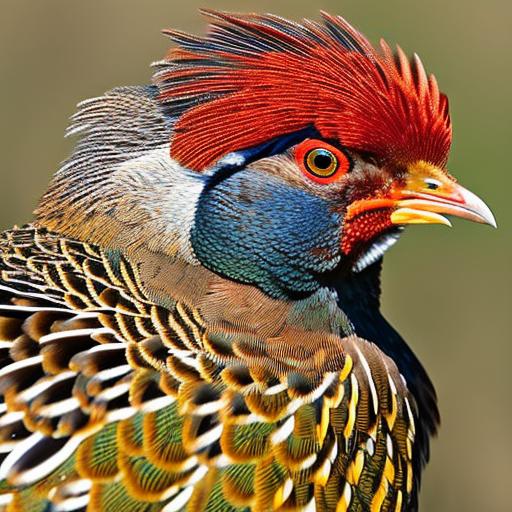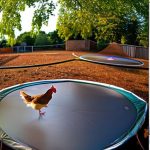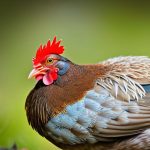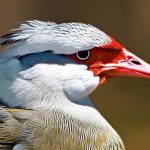Pheasants and chickens are both popular choices for backyard poultry enthusiasts. Pheasants are known for their vibrant plumage and graceful appearance, while chickens are beloved for their friendly nature and ability to provide fresh eggs. Both species have their own unique characteristics and benefits, making them great pets for those interested in raising poultry.
Pheasants are native to Asia and are often kept for their beauty and ornamental value. They come in a variety of colors and patterns, with the males typically having more elaborate plumage than the females. Pheasants are known for their ability to fly, making them a stunning addition to any backyard or aviary.
Chickens, on the other hand, are domesticated birds that have been bred for thousands of years for their meat and eggs. They come in various breeds, each with its own unique characteristics and appearances. Chickens are known for their social nature and can be quite friendly and affectionate towards their owners.
Key Takeaways
- Keeping pheasants and chickens together can provide benefits such as pest control and increased egg production.
- Pheasants and chickens have different temperaments and behaviors, with pheasants being more flighty and less social.
- Housing requirements for pheasants and chickens differ, with pheasants needing more space and higher perches.
- Feeding and nutrition for pheasants and chickens also differ, with pheasants requiring more protein and insects in their diet.
- Health concerns and disease prevention are important for both species, with regular check-ups and vaccinations recommended.
Benefits of Keeping Pheasants and Chickens Together
Keeping pheasants and chickens together can have several benefits. Firstly, they can provide companionship for each other. Pheasants and chickens are social animals that thrive in the company of others. By keeping them together, you can ensure that they have a constant source of interaction and companionship.
Another benefit of keeping pheasants and chickens together is pest control. Pheasants are natural foragers and can help keep your yard free from pests such as insects and small rodents. Chickens also have a knack for finding bugs and other pests, making them an excellent addition to any pest control strategy.
Lastly, keeping pheasants and chickens together can result in increased egg production. Chickens are known for their ability to lay eggs regularly, while pheasants can also produce a decent number of eggs. By keeping them together, you can have a diverse range of eggs to enjoy, from the small and colorful pheasant eggs to the larger and more familiar chicken eggs.
Differences in Temperament and Behavior
Pheasants and chickens have different temperaments and behaviors that should be taken into consideration when keeping them together. Pheasants are generally more skittish and flighty compared to chickens. They are wild birds by nature and may take some time to adjust to human presence. Chickens, on the other hand, are domesticated animals that are more accustomed to human interaction.
When kept together, pheasants and chickens may interact differently with each other. Chickens are generally more social and may try to establish a pecking order within the flock. Pheasants, on the other hand, may be more independent and prefer to keep their distance from the chickens. It is important to provide enough space and resources for both species to ensure that they can coexist peacefully.
Housing Requirements for Pheasants and Chickens
| Requirement | Pheasants | Chickens |
|---|---|---|
| Minimum Space per Bird | 10 sq. ft. | 4 sq. ft. |
| Roosting Space per Bird | 8-10 inches | 6-10 inches |
| Nesting Boxes per Bird | 1 | 1 |
| Feeder Space per Bird | 3-4 inches | 3-4 inches |
| Waterer Space per Bird | 1 inch | 1 inch |
| Temperature Range | 50-70°F | 50-70°F |
| Humidity Range | 50-70% | 50-70% |
| Lighting Requirements | 14-16 hours per day | 14-16 hours per day |
When it comes to housing requirements, pheasants and chickens have some similarities but also some differences. Both species require a secure coop and run to protect them from predators and provide shelter from the elements.
The size of the coop and run will depend on the number of birds you plan to keep. Pheasants require more space compared to chickens due to their ability to fly. A general rule of thumb is to provide at least 10 square feet of space per pheasant and 4 square feet per chicken in the coop, with additional space in the run.
Nesting boxes are essential for both pheasants and chickens to lay their eggs. Pheasants prefer secluded nesting areas, so providing nesting boxes with low light levels can help encourage them to lay eggs. Chickens, on the other hand, are more adaptable and can use a variety of nesting boxes.
Roosting bars are also important for both species. Pheasants prefer to roost on branches or perches, while chickens prefer flat roosting bars. Providing a mix of both options can accommodate the needs of both species.
Feeding and Nutrition for Pheasants and Chickens
Pheasants and chickens have different dietary requirements, so it is important to provide them with the proper nutrition. Pheasants are omnivorous birds that require a diet rich in protein. They can be fed a combination of game bird feed, insects, fruits, and vegetables. It is important to provide a balanced diet to ensure their health and well-being.
Chickens, on the other hand, are omnivores that require a balanced diet of grains, protein, fruits, and vegetables. They can be fed a commercial chicken feed that is specifically formulated for their nutritional needs. Supplementing their diet with kitchen scraps and treats can also provide additional nutrients and enrichment.
It is important to provide separate feeding areas for pheasants and chickens to prevent competition and ensure that each species gets the appropriate amount of food. Water should also be provided at all times to keep both species hydrated.
Health Concerns and Disease Prevention

Both pheasants and chickens are susceptible to certain health issues and diseases. Common health issues in pheasants include respiratory infections, parasites, and injuries from flying into objects. Chickens can also suffer from respiratory infections, parasites, and egg-laying issues.
To prevent disease, it is important to maintain good hygiene practices in the coop and run. Regularly cleaning and disinfecting the coop can help prevent the spread of bacteria and parasites. Providing clean bedding and fresh water can also help maintain good health.
Regular veterinary check-ups are recommended for both pheasants and chickens to ensure that they are in good health. Vaccinations may also be necessary to protect against certain diseases.
Breeding and Reproduction of Pheasants and Chickens
Breeding pheasants and chickens can be a rewarding experience. Pheasants typically breed in the spring, with the males displaying elaborate courtship behaviors to attract females. The female pheasant will lay a clutch of eggs in a secluded nest, and both parents will take turns incubating the eggs.
Chickens can breed throughout the year, with the rooster mating with the hens to fertilize the eggs. The hens will then lay eggs in the nesting boxes, and if left unfertilized, they will not hatch.
Incubation and hatching can be done naturally by the parents or artificially using an incubator. It is important to provide a suitable nesting area for pheasants and chickens to ensure successful breeding and hatching.
Integrating Pheasants and Chickens into Your Flock
Integrating new birds into an existing flock can be a delicate process, but with proper planning and care, it can be done successfully. When introducing pheasants or chickens to an existing flock, it is important to quarantine them for a period of time to ensure that they are healthy and free from any diseases.
Once the quarantine period is over, introducing the new birds gradually can help reduce stress and aggression. Providing enough space and resources for all birds can also help prevent competition and aggression.
Monitoring the interactions between the birds during the integration process is important. If any signs of aggression or bullying are observed, it may be necessary to separate the birds temporarily until they can coexist peacefully.
Tips for Successful Coexistence
To ensure successful coexistence between pheasants and chickens, there are a few tips to keep in mind. Firstly, providing enough space is crucial. Both pheasants and chickens require ample space to move around and establish their territories.
Secondly, it is important to prevent aggression between the birds. This can be done by providing multiple feeding and watering stations to prevent competition. Providing hiding spots and perches can also help reduce stress and aggression.
Lastly, monitoring the birds’ behavior and health regularly is important. Any signs of illness or aggression should be addressed promptly to ensure the well-being of all birds.
The Joy of Raising Pheasants and Chickens Together
Raising pheasants and chickens together can be a rewarding experience for poultry enthusiasts. The companionship, pest control, and increased egg production are just a few of the benefits of keeping these two species together.
While they have their differences in temperament and behavior, with proper planning and care, pheasants and chickens can coexist peacefully. Providing the appropriate housing, nutrition, and healthcare can help ensure the health and well-being of both species.
If you are considering raising poultry in your backyard, why not consider adding both pheasants and chickens to your flock? The vibrant beauty of the pheasants combined with the friendly nature of the chickens can create a unique and enjoyable experience for any poultry enthusiast.
If you’re wondering whether you can keep pheasants with chickens, you might find this article on Poultry Wizard helpful. It provides insights and tips on how to successfully house pheasants and chickens together. Check it out here.
FAQs
What are pheasants?
Pheasants are a type of game bird that are often hunted for sport or kept as pets. They are native to Asia but have been introduced to other parts of the world, including North America.
Can pheasants be kept with chickens?
It is possible to keep pheasants with chickens, but it is not recommended. Pheasants have different dietary and environmental needs than chickens, and they may not get along well together.
What are the differences between pheasants and chickens?
Pheasants are larger and more colorful than chickens, and they have different dietary and environmental needs. Pheasants are also more flighty and may be more difficult to handle than chickens.
What do pheasants eat?
Pheasants eat a diet that is high in protein, including insects, seeds, and small animals. They may also eat fruits and vegetables.
What do chickens eat?
Chickens eat a diet that is high in protein, including insects, seeds, and grains. They may also eat fruits and vegetables.
What are the risks of keeping pheasants with chickens?
Keeping pheasants with chickens can increase the risk of disease transmission between the two species. Pheasants may also be more aggressive than chickens and may harm or kill them.
What should I consider before keeping pheasants with chickens?
Before keeping pheasants with chickens, you should consider the dietary and environmental needs of both species, as well as their compatibility. You should also be prepared to provide separate housing and feeding areas for each species to reduce the risk of disease transmission.
Meet Walter, the feathered-friend fanatic of Florida! Nestled in the sunshine state, Walter struts through life with his feathered companions, clucking his way to happiness. With a coop that’s fancier than a five-star hotel, he’s the Don Juan of the chicken world. When he’s not teaching his hens to do the cha-cha, you’ll find him in a heated debate with his prized rooster, Sir Clucks-a-Lot. Walter’s poultry passion is no yolk; he’s the sunny-side-up guy you never knew you needed in your flock of friends!







